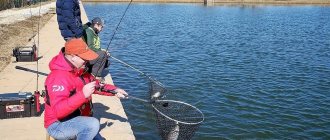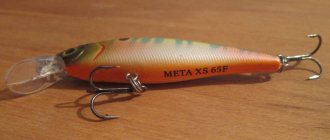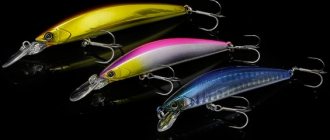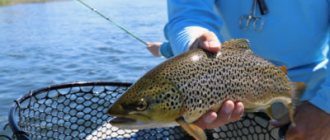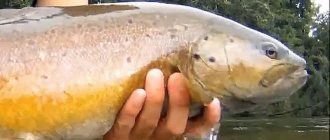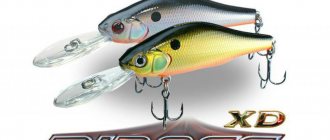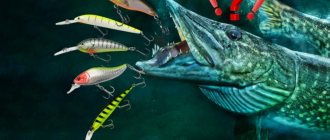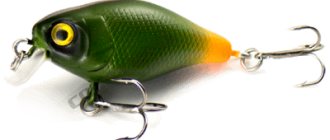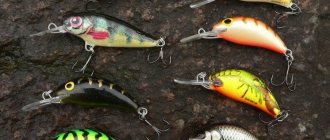Trout, which has considerable strength and beauty, has long been the queen of mountain rivers and a desirable prey for spinning anglers. This fish species, like grayling, chooses the upper reaches of rivers, where clean water predominates, as its habitat. Most rivers are suitable habitat for spotted trout or "speckled trout", and the rainbow's native habitat is ponds, where it is subject to commercial hatching and rearing. In this article we will look at the topic “Wobblers for trout: the 10 best” and talk in as much detail as possible about the fishing technique. Now in large cities, the area-fishing method for rainbow trout, which is a process of fishing from stocked reservoirs or paid ponds, is characterized by popularity.
Which option should I use for fishing?
Recently, fishing methods have undergone changes, as a result of which athletes are divided into two categories: admirers of fishing with silicone and opponents of this method, who use oscillating spoons and wobblers, as in Japanese competitions. You can argue for a long time, but a real professional must have the skills to fish in different ways and use all categories of bait. Depending on your mood, you can first fish with rubber, and then move on to fishing with wobblers.
ZipBaits Orbit 65
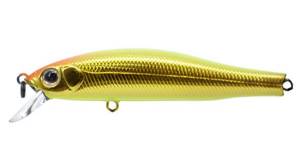
This wobbler was not made for trout. It was purchased in addition to its older brothers - the 80th and 110th. Initially, I expected to use it to catch perch and small pike in flat reservoirs. However, when I became interested in trout fishing with a spinning rod, and had several successful fishing trips with 5 cm wobblers, which seemed large to me for trout fishing, I decided to experiment a little and try larger lures. That’s how I came to catch trout on the 65th orbit. The results exceeded all expectations! The wobbler turned out to be very effective for catching brooks of various sizes. Even individuals up to 200 grams were caught on it! But still, this beast needs to be placed where there is a chance of catching a trophy. Large trout respond to Orbit just fine. Wiring is best done at a fairly high tempo, with aggressive notes.
Thanks for your attention, friends!
No tail, no scales.
How to prepare a wobbler for ultra-slow retrieve?

The key to good fishing in cold water using wobblers is a clear understanding of the situation and the ability to distinguish between suspenders and floating baits, since they require different methods of retrieving, and the fish’s reaction to them is different and depends on its own mood. When fishing in several reservoirs, using the “catch and release” principle, the use of only barbless single hooks is allowed, and after changing conventional hooks, for example, to Owner S-35BL No. 6 or No. 7, the buoyant properties of the bait change. To return wobblers to their original characteristics and slow down the ascent speed, it is advisable to load factory baits using lead plates such as Pontoon-21 Suspendots to the required conditions.
The most catchy types of bait should be loaded with up to three levels of buoyancy: slowly sinking, suspending and weakly floating. It would be a good idea to keep the standard pop-up baits. To increase the efficiency of the fishing process, you should resort to the method of long pauses, when the fish watches the bait, in different situations preferring a suspender or a weakly floating bait. It is not possible to predict the choice of fish, so it is advisable to stock up on all types of bait.
What is the wobbler game used for?
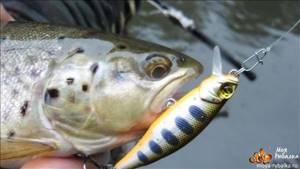
For stable trout fishing in cold water conditions, it is necessary to correctly retrieve the bait. It is a common belief that when fishing for fish, especially trout, the wobbler needs to play. Accordingly, it is necessary to conduct it using uniform wiring and monitoring the fluttering tip on a spinning rod, or twitching, forcing the bait to twitch and throw.
When fishing, non-standard situations may arise that require an original approach. Repeatedly in our practice, we have noticed an amazing moment when fishing for trout using wobblers, especially at the end of the autumn period.
The fish grabs the bait not only during a long pause lasting up to 6 seconds, but also bites a wobbler that barely moves in the water. Here the essence of the wiring is:
- make a small number of slow rotations of the reel drive handle and, thereby, achieve the required depth of the bait.
- Next, a couple of light jerks are made, achieving a slight shudder and turning the bait to the side with slight lateral swaying (rolling).
- Then you need to take a long pause of 4-6 seconds and slowly reel in the fishing line, literally picking up the slack from its sagging for 10-15 seconds. During this period of time, the wobbler, without playing, will move forward slightly.
- After this action, you need to make a jerk and again take a long pause.
A bite from a fish can be expected at any second: both immediately after the jerk, and during a slight movement of the wobbler forward or in the final phase of the pause.
Note that this technique is a very slow retrieve, because in the time spent it is possible to make up to three retrieves of the spinner using an even pace, but for this you need to psychologically tune in to be able to restrain your impatience. On the next cast, we delay the pause for about a second. Although this may seem like a small thing, this technique brought us a good bite of trout.
The contrasting color of the bait plus the skillful technique of holding it in the bite zone with alternating light jerks and slow movement perfectly attract fish.
We have noticed that when the speed of movement of the bait is correctly selected, then the fish becomes less demanding towards the horizon of its movement.
If, for example, the movement of a spoon or crank occurs at a low or even higher speed, then it is necessary to move the bait at the required depth with an approximate accuracy of 0.3 to 0.4 m. When fishing with a wobbler, using an ultra-slow pause, the specified distance should be slightly increased, which will allow the fish to become more captivated by the bait over a longer period of time and be more likely to decide to attack.
It is necessary to understand that the behavior of a wobbler depends on its model and differs for different cases: be it a slow reeling or a sustained pause. Pisces choose the model that seems more attractive to them.
Features of trout wobblers
Choosing a wobbler for trout fishing must take into account the lifestyle of the fish and the type of reservoir. For example, rainbow trout raised in farmsteads are very different from their wild river counterparts in both appearance and habits.
Trout lures must have an attractive high-frequency action and stability when retrieved. This means that the wobbler must oscillate with the same amplitude, without falling over or going off course. Chaotic movements can easily alert a cautious predator.
Requirements for baits
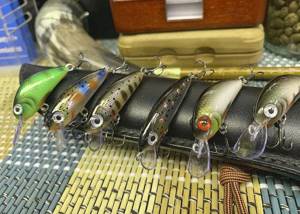
Small fish quite often land on wobblers. Usually, catching a trout weighing 1.5-2 kg is a great success; more often you come across fish weighing only up to 0.5 kg. It is better to use compact light class baits (4-5 grams, 4.5-5 cm long).
Important. When choosing the shape and color of a wobbler, they are guided by the food supply of the predator. Water transparency, reservoir depth and weather also make adjustments.
Colors
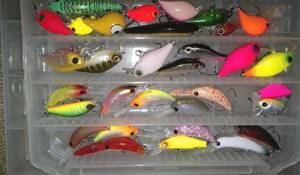
The color of the bait can easily decide the outcome of fishing, because trout can change their preferences several times a day.
While fishing, you should constantly change bait, especially if after a series of casts there are no trout bites. The best colors are:
- white;
- black;
- red;
- pink;
- acid green.
Recommended reading: How to make semolina for fishing
Wobblers with acid colors are often fired on pay sites. As a rule, they work better in summer, in warm water. However, if presented correctly, you can count on bites in the colder months.
“Trout” types of wobblers

Next, the 10 best wobblers for trout will be presented.
"Smith Camion"
The most famous line of crankbait wobblers made in Japan. They have excellent resistance to flow. They come in a variety of excellent colors that are indispensable when fishing for brook trout.
"ZipBaits Hickory & Baby Hickory"
Japanese cranks with excellent workmanship. This proven product is an excellent choice for an amateur when fishing for trout, chub or perch.
"Nories Pupa"
An excellent mini-wobbler with a very accurate imitation of a bug. It has proven itself excellent on small rivers and streams against any predator, not excluding trout.
"Zip Baits Rigge"
The well-known Japanese manufacturer of the minnow series has many options in its assortment that are absolutely suitable for trout fishing, the sinking versions of Rigge 35F, 35SS, 46S, 50S are especially popular.
"Rupala Husky Jerk"
A good minnow wobbler with a rich history of use. Has proven itself excellent among trout fishing enthusiasts. The most suitable would be to use a smaller version - 60 mm, 3 g.
"Salmo Hornet"
The wide range of Salmo lures includes modifications suitable for trout. There are standard sizes 2.5; 3 and 4 cm. The variety of colors imitating bugs or tiny fish is amazing.
"Salmo Tiny"
Mini-modifications of wobblers resembling a bug. Best suited for holes or niches, but can also be used in areas with high flow rates.
"LuckyCraft Flat Cra Pea"
A mainstream wobbler that is gaining popularity. The MR and SR models are perfectly applicable to catching predators.
"Lucky Craft Clutch"
Massive crank (4.5 cm). Copes perfectly with the current and is suitable for large trout.
"Jackall Area Man"
Both options: from 2.2 to 2.8 cm will perfectly cope with the task of catching small specimens living in streams. The fish probably mistake them for small bugs.
"Jackall Panicra"
The line of crankbait wobblers has recently appeared, but it copes with its task with a bang.
Trout fishing with Red Rag 36 wobbler
The iconic wobbler for catching not only brook trout, but also many other fish is the famous Rigge 35. This wobbler is available in two versions: floating and sinking.

There is also a kind of deep-sea fish that goes to a depth of more than 1 m. Therefore, using the collection of Rigge 35 models, you can catch trout in almost any conditions, especially if the fish is in the upper layers of the water.
There is another excellent wobbler that can compete with the Rigge 35. This is the Chubby Minnow bait from the Jackall company, which has all the necessary qualities.
Rigge 35
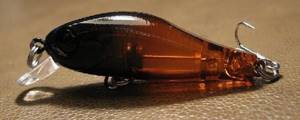
Also good options would be Presso Minnow 4 °F (length 40 mm, weight 1.8 g) from Daiwa, Elfin Cricket 37 °F from Tackle House (37 mm length, 2 g weight), Tiny Fry from the same Jackall (48 mm, 1.5 g), as well as a larger wobbler from Lucky Craft with a length of 45 mm and a weight of 2.7 g - Bevy Minnow 45SP.
However, you shouldn’t limit yourself to “minnies”. It would be appropriate to grab Camion Smith, floating and sinking Cooky 38SP, Hornet and Tiny models from Salmo. These wobblers are also very attractive to any trout and in different bodies of water.
Applicability of wobblers on paid sites
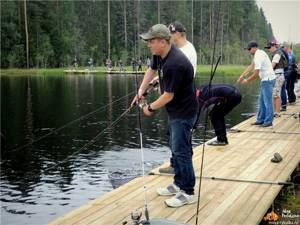
Many people now have a question about the applicability of the specified list of wobblers to trout if there are ponds, lakes or pay zones as fishing grounds. Now this direction is becoming increasingly popular, since not everyone has the opportunity to travel deep into nature to wild streams or mountain rivers. But the process of fishing in such remote places in conditions of unity with nature will repay the spinning angler with repeated pleasure.
As for reservoirs located near civilization, for example, pay zones, then for such fishing it is possible to impose slightly more gentle requirements on wobblers, in comparison with the analogues used, as during wild fishing. Here the relaxation comes from the absence of the need for excellent stability of the wobbler when playing in the current. Trout in free-form fisheries, as a rule, are larger in size than in brook trout, so larger baits can also be used. The colors of the baits play an important role: for streams, specimens of matte: dark or silver shades, preferably speckled, are better suited, and for the payer bait, bright options are suitable: with yellow, pink flowers, etc.
